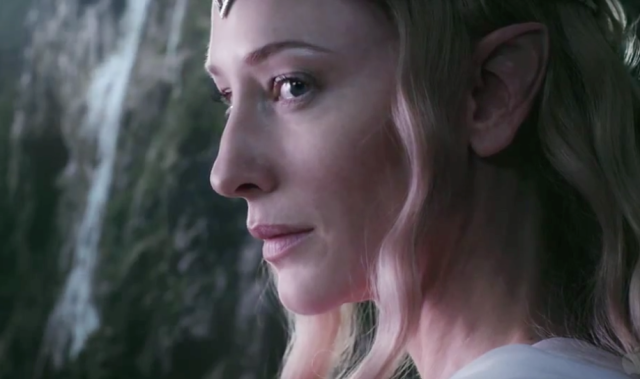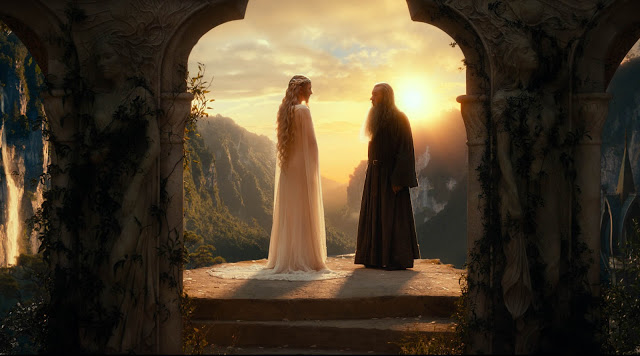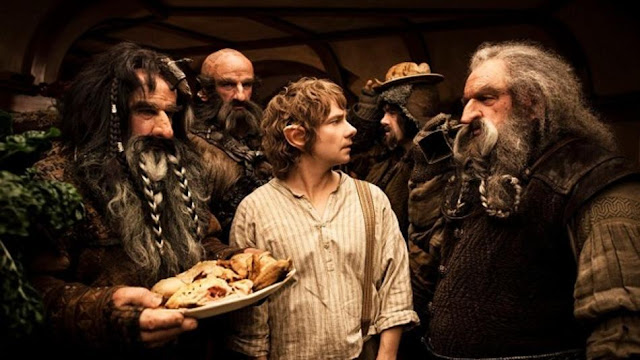Guest post written by Elise Schwartz.
The Hobbit: An Unexpected Journey directed by Peter Jackson is the prequel story to The Lord of the Rings trilogy. It begins by introducing the protagonist, Bilbo Baggins, on the day of his 111th birthday, the same day that the Lord of the Rings: The Fellowship of the Rings movie begins. It is the day that Baggins begins writing about the greatest adventure of his lifetime: an unexpected journey. The movie dialogues Baggins’ first encounter with Gandalf the Grey, a host of Dwarves, Elves, Orcs and Goblins, while assisting the Dwarves in their quest to reclaim the Lonely Mountain.
This Hobbit movie, which will eventually be the first part in a trilogy, is based on roughly the first half of J.R.R. Tolkien’s The Hobbit. The book was published in the late 1930s and was intended to be a stand-alone children’s book. The LOTR trilogy only came to be as a request from Tolkien’s publisher. It was during this trilogy that Tolkien really developed Middle Earth and the characters that lived within its regions. It’s possible that due to the fictional world not being truly developed prior to The Hobbit being published, we only meet the 15 male characters that make up the traveling party and their enemies. Jackson took it upon himself to bring the two stories together as a whole movie series by introducing additional characters to the audience of The Hobbit that play a large roles in the LOTR. One main example of this is through the character Galadriel, the Elf Queen.
Galadriel appears in a scene that was created specifically for the movie adaptation. During this scene there is a meeting of the White Council, which consists of Gandalf the Grey, Saruman the White, Elrond the Lord of Rivendell and Galadriel. The council meets to discuss the mission of the traveling party to take back the Lonely Mountain and the role of Baggins as part of the company. Galadriel remains quiet and watchful during much of the meeting’s discussions. Though, she does interject during a heated debate between Gandalf and Saruman, and insists that Saruman let Gandalf speak. At the conclusion of the meeting, she offers Gandalf guidance and assistance if he were to ever need her help.
The members of the council treat Galadriel in an ethereal, yet mindful way. They show her respect in a manner that almost makes it seem like she should be placed on a pedestal. It is much how she and other female characters are regarded in the LOTR. Jackson was careful to show this in the style that it was intended – with dignity and admiration towards women of power.
 |
| Galadriel (Cate Blanchett) in The Hobbit: An Unexpected Journey |
Many other reviews such as this one have questioned why Galadriel was included in the film, when her character wasn’t introduced in the book. Was this just a way of adding females into the plot line? It’s possible. But we must remember that Jackson is tying the two series together and trying to create cohesion, which will turn into a much grander story overall. So why didn’t he include Arwen or Eowyn? Simply from a historical timeline, this is 60 years prior to the LOTR stories and Galadriel was the only female character Tolkien introduced that was alive at the time. As well, she is a character of authority that can add substance to the overall journey of the series.
So, even though The Hobbit was not meant to hold a well-rounded cast, Jackson’s film adaptation of the first half of the book does an exceptional job of introducing the audience to the world of Middle Earth and the characters within. He was careful to insert only the most necessary characters that needed introduction while sticking to the main themes and plot directions of the book. Though, I’m still curious to know if he will end up pushing the envelope enough with the Hobbit series to take home another Best Picture award in the future.
———-
Elise Schwartz writes at HalloweenCostumes.com and has been known to spend an entire weekend watching the extended versions of the Lord of the Rings films start to finish.


